Population structure of Oncidium poikilostalix (Orchidaceae), in coffee plantations in Soconusco, Chiapas, México
DOI:
https://doi.org/10.15517/lank.v11i1.18312Palabras clave:
Oncidium poikilostalix, micrositio, estadíos de vida, forofito, árbol de sombra, cafetoResumen
Se estudió la estructura poblacional de la orquídea epífita Oncidium poikilostalix (Kraenzl.) M.W. Chase & N.H. Williams (Orchidaceae), nuevo reporte para México en 2008, en la región del Soconusco, Estado de Chiapas, al sureste del país. Crece en plantaciones de café de sombra en dos comunidades rurales, Fracción Montecristo (FM) y Benito Juárez El Plan (BJ). En 2008-2009, se determinaron las características de estas plantaciones de café, y la distribución de los distintos estadíos de vida (plántulas, juveniles, adultos) de esta orquídea, en los dos forofitos encontrados: plantas de café (Coffea arabica L.) y árboles de sombra (Inga micheliana Harms.). Se utilizó Análisis de Componentes Principales y Análisis Discriminante, para comparar todas las variables evaluadas. Hubo 1.123 individuos (82,63%) de O. poikilostalix en FM y 236 (17,37%) en BJ. De ellos, creciendo sobre cafetos, 1.060 individuos (94,4%) en FM y 214 (91,06%) en BJ, el resto ocupando árboles de sombra (I. micheliana). A pesar de mostrar las características de una epífita de ramilla, el mayor número de ejemplares de O. poikilostalix se contabilizó en los cafetos, en el micrositio ramas, con 703 individuos (55,18%) y en el tronco, en los árboles de sombra, con 78 individuos (91,76%). Más de un tercio de la población fueron individuos juveniles (504 individuos, 37,09%). Oncidium poikilostalix probablemente entró a México desde Guatemala y parece ser una planta vigorosa, que se está adaptando con éxito a sus nuevos sitios de ocupación.
Descargas
Descargas
Publicado
Cómo citar
Número
Sección
Licencia
Conforme con las Políticas de Acceso Abierto promovidas por la Universidad de Costa Rica, los derechos de autor de todos los artículos publicados en Lankesteriana se encuentran bajo una licencia Creative Commons y pueden ser descargados gratuitamente. Los derechos de autor y de publicación pertenecen a la revista bajo la licencia CC BY-NC-ND 3.0 CR.
Before the publication of the materials submitted by the author(s) in LANKESTERIANA, the author(s) hereby assign all rights in the article to the Lankester Botanical Garden.





